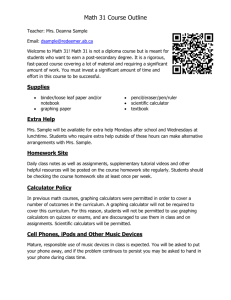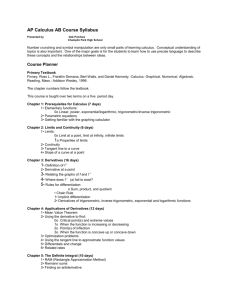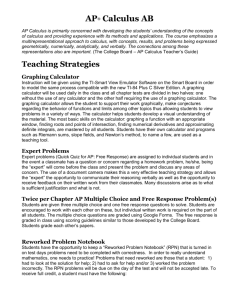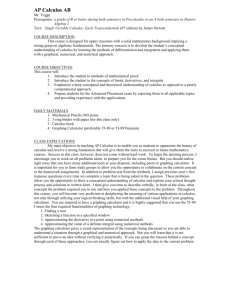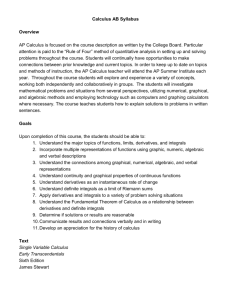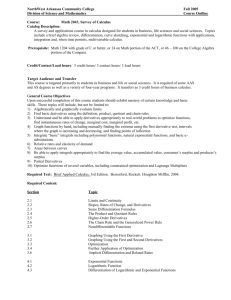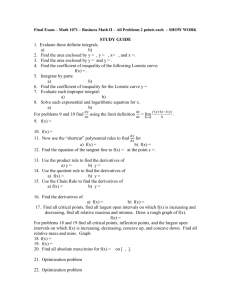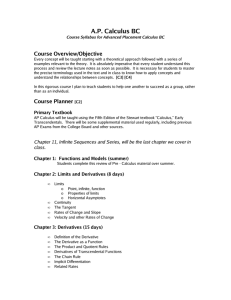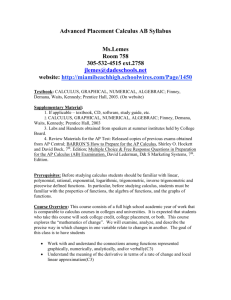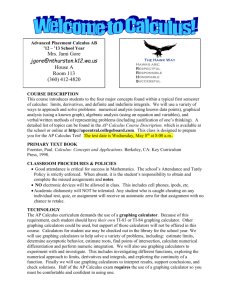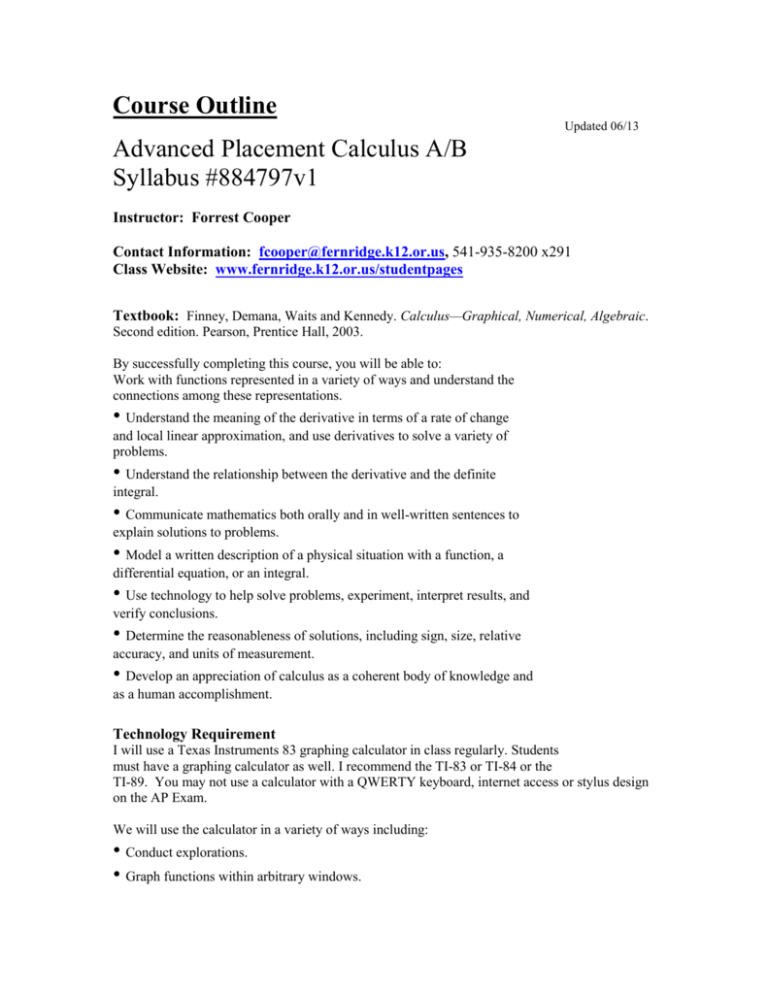
Course Outline
Updated 06/13
Advanced Placement Calculus A/B
Syllabus #884797v1
Instructor: Forrest Cooper
Contact Information: fcooper@fernridge.k12.or.us, 541-935-8200 x291
Class Website: www.fernridge.k12.or.us/studentpages
Textbook: Finney, Demana, Waits and Kennedy. Calculus—Graphical, Numerical, Algebraic.
Second edition. Pearson, Prentice Hall, 2003.
By successfully completing this course, you will be able to:
Work with functions represented in a variety of ways and understand the
connections among these representations.
• Understand the meaning of the derivative in terms of a rate of change
and local linear approximation, and use derivatives to solve a variety of
problems.
• Understand the relationship between the derivative and the definite
integral.
• Communicate mathematics both orally and in well-written sentences to
explain solutions to problems.
• Model a written description of a physical situation with a function, a
differential equation, or an integral.
• Use technology to help solve problems, experiment, interpret results, and
verify conclusions.
• Determine the reasonableness of solutions, including sign, size, relative
accuracy, and units of measurement.
• Develop an appreciation of calculus as a coherent body of knowledge and
as a human accomplishment.
Technology Requirement
I will use a Texas Instruments 83 graphing calculator in class regularly. Students
must have a graphing calculator as well. I recommend the TI-83 or TI-84 or the
TI-89. You may not use a calculator with a QWERTY keyboard, internet access or stylus design
on the AP Exam.
We will use the calculator in a variety of ways including:
• Conduct explorations.
• Graph functions within arbitrary windows.
• Finding a root
• Using numerical methods, solve equations and approximate the derivative at a point or
approximate the value of a definite integral.
• Analyze and interpret results.
• Justify and explain results of graphs and equations.
[C5]
AP Standards Notation
C2—The course teaches all topics associated with Functions, Graphs, and Limits;
Derivatives; Integrals; and Polynomial Approximations and series as delineated in the
Calculus Topic Outline in the AP Calculus Course Description.
C3—The course provides students with the opportunity to work with functions
represented in a variety of ways—graphically, numerically, analytically, and verbally—
and emphasizes the connections among these representations.
C4—The course teaches students how to communicate mathematics and explain
solutions to problems both verbally and in written sentences.
C5—The course teaches students how to use graphing calculators to help solve problems,
experiment, interpret results, and support conclusions.
Course Timeline
Chapter 1
1.1
1.2
1.3
1.4
1.5
1.6
11 days
Lines
Functions and Graphs
Exponential Functions
Parametric Equations
Functions and Logarithms
Trigonometric Functions
Review and Test
Chapter 2
2.1
2.2
2.3
2.4
Prerequisites for Calculus
Limits and Continuity
Rates of Change and Limits
Limits Involving Infinity
Continuity
Rates of Change and Tangent Lines
Review and Test
10 days
Student Activity: Investigation of Limits [C2], [C3], [C4], [C5]
Student Activity: Sandwich Theorem [C3], [C5]
Chapter 3
3.1
3.2
3.3
3.4
3.5
3.6
3.7
3.8
3.9
Derivatives
30 days
Derivative of a Function
Differentiability
Rules for Differentiation
Velocity and Other Rates of Change
Derivatives of Trigonometric Functions
Review and Test
Chain Rule
Implicit Differentiation
Derivatives of Inverse Trigonometric Functions
Derivatives of Exponential and Logarithmic Functions
Review and Test
Student Activity: Derivatives Activity: Falling objects [C2], [C3], [C4], [C5]
Student Activity: Graphing Derivatives [C2], [C3], [C4], [C5]
Chapter 4
4.1
4.2
4.3
4.4
4.5
4.6
Applications of Derivatives
25 days
Extreme Values of Functions
Mean Value Theorem
Connecting f’ and f” with the Graph of f
Modeling and Optimization
Linearization and Newton’s Method
Related Rates
Review and Test
Student Activity: Optimum Can [C2], [C3], [C4]
Student Activity: Optimum Can [C2], [C3], [C4]
Student Activity: Local Linearization [C3], [C4], [C5]
Chapter 5
5.1
5.2
5.3
5.4
5.5
26 days
Estimating with Finite Sums
Definite Integrals and Reimann Sums
Definite Integrals and Antiderivatives
Fundamental Theorem of Calculus
Trapezoidal Rule
Review and Test
Chapter 6
6.1
The Definite Integral
Differential Equations and Mathematical Modeling
Antiderivatives and Slope Fields
22 days
6.2
6.4
6.5
6.6
Integration by Substitution
Exponential Growth and Decay
Population Growth
Numerical Methods
Review and Test
Student Activity: Slope Fields Single Variable Activity [C3], [C4], [C5]
Chapter 7
7.1
7.2
7.3
7.4
7.5
8.1
Applications of Definite Integrals
21 days
Integral as Net Change
Areas in the Plane
Volumes (discs, washers, cylindrical shells and cross sections)
Lengths of Curves
Science and Statistics Applications and Modeling
L’Hopital’s Rule (connects derivatives and limits)
Review and Test
Student Activity: Speed vs. Time [C2], [C3], [C4]
Student Activity Set: Modeling Volumes of Solids
[C2], [C3], [C4], [C5]
Final Review and AP Exam Preparation
12 days
A. Multiple-choice practice (Items from released exams
as well as other resources, such as course websites)
1. Test taking strategies are emphasized
2. Individual and group practice are both used
B. Free-response practice (Released items from the AP Central website)
1. Rubrics are reviewed so students see the need for complete answers
2. Students collaborate to formulate team responses
3. Individually written responses are crafted, with emphasis on attention to full
explanations. [C4]
“After the AP Exam” Topics
6.3
8.2
8.4
10 days
Integration by Parts
Improper Integrals
Partial Fractions
Teaching Strategies
We will begin on day one with instruction on prerequisites (chapter 1). During the week
following, we will integrate AP-specific information about the nature of the test,
calculator usage, etc. Students will be required to obtain a graphing calculator that is
appropriate for the test to use for exploration and discovery during this course. [C5]
During a regular class session, time will be divided between small groups of students
working together to check their work and collaborate on problems, and direct instruction to
model different methods, to help with understanding, and to keep students focused and
moving forward. Students will be called on regularly to demonstrate their solution to a
complex problem. [C3, C4]
A video projector and the internet are connected to a computer in the classroom, so a variety
of technology resources can be employed, including online graphing calculators, online
videos, scanned diagrams and graphic charts and explanations. This technology will be
especially employed during the studies of functions, graphs, solid modeling, derivatives and
integrals. [C2, C3, C5]
Student Evaluation
Beginning in October, students will be assigned free-response questions at regular
intervals to submit for an AP-level grade. This grade will constitute quiz scores in the
first semester.
At the end of January, students will take a Multiple-choice AP test (released exam),
which will inform them of their progress and help encourage students to continue in the
second semester and to sign up for the exam.
Grading
Tests: 40%
Assignments: 20%
Quizzes: 10%
Final Exam: 20%
Guided Assessment (labs, barbeque, in-class activities, etc.): 10%
Student Activities
During the first few weeks, we spend extra time familiarizing students with their
graphing calculators. Students are taught the rule of four: Ideas can be investigated
analytically, graphically, numerically, and verbally. Students are expected to relate
the various representations to each other. [C3, C5]
• Analytic/algebraic analysis (traditional equation and variable
manipulation)
• Graphical analysis (where a graph is known, but again, not an equation)
• Numerical analysis (where data points are known, but not an equation)
• Verbal/written methods of representing problems (classic story problems
as well as written justification of one’s thinking in solving a problem—
such as on our state assessment) [C3]
The Fern Ridge Board of Education and Fern Ridge School District Policy deem there will be no
discrimination or harassment on the grounds of race, color, sex, marital status, religion, national origin, age,
or disability in educational programs, activities or employment. Person(s) having questions about equal
opportunity, discrimination or harassment should contact the Superintendent at the Fern Ridge School
District, 88834 Territorial Road, Elmira, OR 97437, Phone (541) 935-2253.

